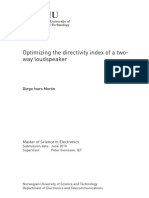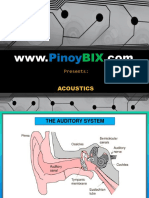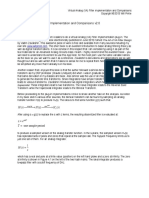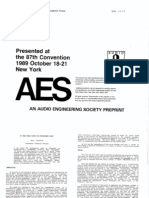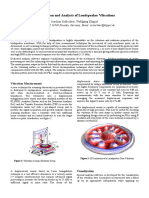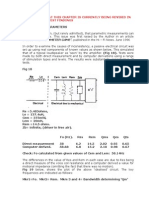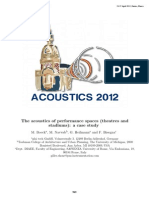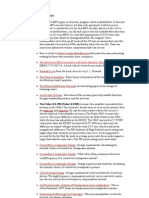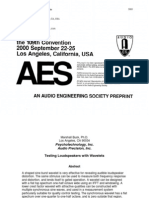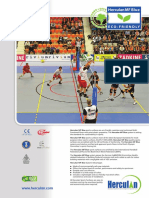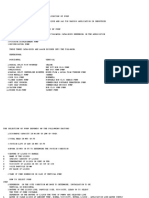Reverberation algorithms
Augusto Sarti
�Summary
n n n
The Reverb Problem Reverb Perception Acoustic impulse response:
Formation mechanisms Parameters
n n n
Early Reflections Late Reverb Numerical reverberation algorithms
Schroeder Reverbs Feedback Delay Network (FDN) Reverberators Waveguide Reverberators
Geometrical reverberation algorithms
�Impulse response
n n
The sounds we perceive heavily depend on the surrounding environment Environment-related sound changes are of convolutive origin (filtering)
Well-modeled
by a space-varying impulse response
�Impulse response
Amplitude
Time Direct signal Early reflections Reverberations
�Reverberation tf Function
Three sources, one listener (two ears) n Filters should include pinnae filtering n Filters change if anything in the room changes (exact model)
n
�Global descriptors
n
Energy decay curve (EDC)
Introduced by Schroeder to define reverberation time It measures the total signal energy remaining in the reverberators impulse response at time t It decays more smoothly than the impulse response, therefore it works better than the amplitudes envelope for defining the reverberation time In reverberant environments a large amount of the total energy is contained in the last portion of the impulse response
Reverberation time
T 60 = {t : EDC (t ) =EDC (0) 60dB}
�Global descriptors
�EDR of a violin body
�Global descriptors
n
In the rooms transfer function we can single out resonant modes The spacing between two resonant modes is given by
which is valid above the threshold frequency
�Global descriptors
n
Number of echoes in the impulse response before time t
Derivative of Nt:
Clarity index: ratio btw early reflections energy and late reverberation energy
�Implementation
�����������������Moorer reverberator
n
accounts for late reverberations by placing an IIR filter after the FIR filter (tapped delay line)
�Binaural impulse response
n Our
sound perception is affected by our own body
Head
Related Transfer Function (HRTF)
Acoustic paths can be grouped together to reduce cost
�Comb filter
�Allpass filter
���Steady-state tones (sinusoids) really do see the same gain at every frequency in an allpass, while a comb filter has widely varying gains
�Comb filters and reverberation time
n
The decay between successive samples in comb and allpass filters is described by the gain coefficient gi In order for the comb filters decay to correspond to a given reverberation time, we must have
�Combination of comb filters
n n
Single comb filters do not provide sufficient echo density In order to improve the echo density, we need to combine multiple comb filters
Cascading comb filters corresponds to multiplying their transfer functions Frequency peaks not shared by all comb filters are cancelled by multiplication
�Combination of comb filters
n Better
to place comb filters in parallel
Example
�Parallel comb filters
n
The poles of comb filters are given by
The poles have the same magnitudes
The modal density (No. of modes per Hz) is
�Parallel comb filters
n n n
Modal density turns out to be the same at all frequencies, unlike real rooms Above a threshold frequency, the modal density is constant The modal density of the comb filters is then set to the modal density above the threshold frequency
�Parallel comb filters
n
The echo density of the comb filters is approximatively given by
Relating echo density and modal density provides:
�Combination of allpass filters
n
Unlike comb filters, allpass filters must be cascaded
Multiplying
freq. responses corresponds to adding phase responses
�Schroeders reverberator (1)
��Schroeders reverberator
n
Delays of the comb and allpass filters are chosen so that the ratio of the largest and smallest delay is 1.5 (typically 30 and 45 ms) The gains gi of the comb filters are chosen to provide a desired reverberation time Tr according to
Allpass filters delays are set to 5 and 1.7 ms
����Feedback Delay Networks at a glance
n
Unitary matrix: definition
A matrix is unitary if :
|| M u ||=|| u ||
We can also write that a matrix is unitary if
|| MMT ||=|| MT M ||= 1
�FDN
a11 a12 a 21 a22 A= a31 a32 a41 a42 a13 a23 a33 a43 a14 a24 a34 a44
Stability of the feedback loop is guaranteed if A = gM where M is an unitary matrix and |g|<1 Outputs will be mutually incoherent: we can use the FDN to render the diffuse soundfield with a 4 loudspeaker system The early reverbeartions can be simulated by appropriately injecting the input signal into the delay lines
�Jots reverberator
c =[
a11 a12 a1N a a22 a2 N 21 A = a N 1 a42 a4 N
b1 b = bN
c1 c = c N
�Jots reverberator
The input-output relation of Jots reverberator is given by
with
and
�Jots reverberator
n System
transfer function:
n Zeros:
n Poles:
�Jots reverberator
n
Moorer noted that convolving exponentially decaying white noise with source signals produces a very natural sounding As a consequence, by introducing absorptive losses into a lossless prototype, we should obtain a natural sounding reverberator This is accomplished by associating a gain with each delay:
�Jots reverberator
n
The logarithm of the gain is proportional to the length of the delay:
n n
The above modification has the effect of replacing z with z/ in the transfer function The lossless prototype response h[n] will be multiplied by an exponential envelope n
�Modeling the Environment
�Modeling the environment
n Simulate
reverberations due to environment
�Motivations
Acoustical environment provides ... n Sense of presence n Comprehension of space n Localization of auditory cues n Selectivity of audio signals (cocktail party effect)
�Geometric acoustic modeling
n
Spatialize sound by computing reverberation paths from source to receiver
�Similarities to Graphics
n
Both model wave propagatation
�Differences from Graphics I
n
Sound has longer wavelengths than light
Diffractions
are significant Specular reflections dominate diffuse reflections Occlusions by small objects have little effect
�Differences from Graphics II
n
Sound waves are coherent
Modeling
phase is important
�Differences from Graphics III
n
Sound travels more slowly than light
Reverberations
are perceived over time
�Overview of approaches
n n n n n
Finite element methods Boundary element methods Image source methods Ray tracing Beam tracing
�Finite element methods
n Solve
wave equation over grid-aligned
mesh
�Boundary element methods
n Solve
wave equation over discretized surfaces
�Boundary Element Trade-offs
n Advantages
Works
well for low frequencies Simple formulation
�Boundary Element Trade-offs
n Disadvantages
Complex
function stored with each element Form factors must model diffractions & specularities Elements must be much smaller than wavelength
�Image source methods
n Consider
direct paths from virtual
sources
�Image source trade-offs
n Advantages
Simple
for rectangular rooms
�Image source trade-offs
n Disadvantages
O(nr)
visibility checks in arbitrary environments Specular reflections only
�Path tracing
n Trace
paths between source and receiver
�Path Tracing Trade-offs
n Advantages
Models
all types of surfaces and scattering Simple to implement
Sampled reverberation s Incoming ray
�Path Tracing Disadvantages
n Disadvantages
Subject
to sampling errors (aliasing) Depends on receiver position
�Beam Tracing
n Trace
beams (bundles of rays) from source
�Beam Tracing Trade-offs
n Advantages
Takes
advantage of spatial coherence Predetermines visible virtual sources
�Beam Tracing Disadvantages
n Disadvantages
Difficult
for curved surfaces or refractions Requires efficient polygon sorting and intersection
BSPs
Cell adjacency graphs
�Complex 3D Environments
n Precompute
beam tree for stationary
source
�Interactive Performance
n Lookup
beams containing moving receiver
�Summary
n FEM/BEM
best best
for low frequencies
n Image n Path
source methods
for rectangular rooms (very common) for high-order reflections (very common)
tracing tracing
for precomputation
best
n Beam
best
�Current research in interactive audio spatialization
�Back to the problem
n
Path/ray tracing according to the laws of geometric optics Applications to
Simulation
of acoustic reverberations in complex environments Prediction of EM propagation for wireless systems (multipath fading)
81
�Beam tracing
n n
Construction of the beam tree through space subdivision Construction of paths through beam tree lookup
82
�Using space subdivision
83
�What is missing?
n Traditional
Every
beam tracing assumes that the source be fixed
time the source moves, the BT needs to be rebuilt from scratch (lengthy process based on space subdivision)
n Is
it possible to avoid space subdivision? n Is it possible to settle all visibility issues in advance (irrespective of the source location)? n Is it ultimately possible to build the BT through a simple lookup process?
84
�Reformulating the problem
n Define
environments visibility independently from the sources location n Compute the environments visibility n Build the beam tree using
Visibility
info Sources location
n Build
the paths using
Beam
tree 85 Receivers location
�Environments characterization
n n
Sources and Receivers
Assumed
to be point-like
Reflectors
Oriented
n n n
surface of a reflecting wall
A reflecting wall defines two reflectors Assumed as flat Identified by an index
Byproducts:
Beams
n n
Compact bundle of rays originated by the same source Identified by a source (real or virtual) and the illuminated portion of a reflector
Active
n n
reflectors
That portion of a reflector illuminated by a beam Identified by a beam and a reflector
86
�Visibility
n
Visibility function
Function
that associates the index of the visible reflector to a viewpoint and a viewing direction Piece-wise constant function that takes on values in the parameter space that characterizes viewpoint and viewing direction
n
Visibility function from a reflector
Visibility
function where viewpoints are constrained on the pts of the reflector of the visibility functions associated to all the environments reflectors
n
Environments visibility description
Set
M reflecting walls => 2M visibility functions
87
�Defining the parameter space
n
Parameter space: viewpoint and viewing direction
If
the point lies on a reflector
n n
4D parameter space in the 3D case 2D parameter space in the 2D case
Reflectors
n
normalization
affine transformation (rigid motion + scaling) of the geometric space that remaps the reflector onto the segment that goes from (0,-1) to (0,1), with reflecting surface facing x0
This
way viewpoint and viewing direction can be described by the eq. y = a x + b, where -1b1 describes the point on the reflector and a the viewing direction
n
Parameter space: (a,b)
88
�Visibility region
n The
visibility region of a given reflector w.r.t. a reference reflector is the region of the parameter space (a,b) that corresponds to viewpoints on the reference reflector from which the given one results as visible
Due
to occlusions, this region can be empty or made of a set of convex polygons
n The
visibility region of reflector i is the region where the visibility function is equal to i
89
�Visibility region
n A
generic reflector can be described by
(e+f,g+h) x=et+f y=gt+h 0t1 Substituting in y=ax+b we obtain (f,h) g t + h = a (e t + f) + b, 0t1 -1b1 Visibility region: Intersection btw a bundle of rays (a beam in parameter space) and the strip -1b1
90
�Examples
91
�Visibility region
n n n
Potential visibility region: visibility region with no other reflectors Potential visibility regions may overlap Actual visibility region is contained within the potential one Overlaps must be resolved considering occlusions Approach for evaluating visibility function Compute potential visibility regions Resolve overlaps and identify actual visibility regions Label actual visibility regions
92
�Resolving overlaps
n When
two potential visibility regions overlap, the corresponding reflectors exhibit a partial occlusion w.r.t. the reference reflector n Who occludes who decides which region eats which on the overlap n This can be done by tracing a sample ray within the overlapping region
93
�Parameter space (dual space)
94
�Reflectors in the dual space
95
�Normalized dual space
96
�Building a beam tree from visibility
n Evaluating
the global visibility of the environment corresponds to building one visibility function per reflector
This
corresponds to constructing and labeling all the actual visibility regions for each reflector
n All
this ignores the location of the source n Given source location and visibility, how do we build the beam tree?
97
�Sources in parameter space
n n
A source in parameter space is a line (dual of a pt) Source and active portion of a reflector define a beam
The
branching of a beam is defined by the intersection btw the line and the actual visibility regions
98
�Beam tracing
n Given
a beam reflected by the i-th reflector, use visibility to to determine its branching in sub-beams (one per visible reflector)
Determine
virtual source location in the warped space corresponding to i-th reflector Determine illuminated portion of reflector and the corresponding narrowed reference strip Scan actual visibility regions over the line corresponding to the source in parameter space Update beam tree 99
�Beam tracing
100
�Computational efficiency
101
�Computational efficiency
102
�103
�Modeling diffraction
n Use
geometric theory of diffraction n Diffraction modeled by placing sources (and the relative beam trees) at diffracting wedges n Beam trees computed in advance jointly with visibility information
104
�A comparison btw imp. responses
Sim.
Meas.
�Comparison
n
Parameters:
EDC Early Decay Time (EDT): time that imp. resp. takes to dim down of 10 dB. Center Time (CT): centroid of squared impulse response
Imp. Resp. envelope:
�EDC
recorded Simulated refl. only
Sim. of refl. + diffr.
Complete simulation
�EDT
recorded Simulated refl. only
Sim. of refl. + diffr.
Complete simulation\
�Centre Time
recorded Simulated refl. only
Sim. of refl. + diffr.
Complete simulation
�Auralization
110
�Active Beamshaping
�Rendering beams
Physical approach: WFS
Geometric appraoch: Beam Tracing
Huygens principle data-based (needs wavefield acquisition) Works on wavefronts
Implements general solution according to geometric propagation principles Boundary conditions become components of the implementation
112
�Goal
Reconstruction of an arbitrary source (arbitrary radiation function) in an arbitrary location using an array of speaker in close range
113
�Signal transfer
=
NxM
Mx1 Nx1
Gh = b
Matrix form
114
�Example (1) central beam
n M
= 16; n f = 700Hz n y = not uniform n Gaussian mask
115
�Example 2 skewed beam
nM
= 64; nf = 700Hz ny = 10 cm nMaschera Gauss
116
�Rendered beam
�Wideband extension
Instead
of setting constraints at a single frequency, we apply them to multiple frequencies (wideband minimization) 4 parameters:
n F,
No. of frequencies where we minimize n M, No. of speakers n N, No. of angles n T, No. of taps of the filter
118
�Example 3 skewed beam
119
�Interface
120
�Testing in a dry room
Multiple audio cards in daisychain configuration 8-16-24 synchronized outputs
15-speaker non-uniform array
121
�Results
n Expected
Low
contrasting needs
frequencies require extensive arrays High frequencies require closely-spaced speakers Cost constrains limit the No. of speakers
n With
15-16 speakers we do not go beyond 17-18 db of attenuation btw main lobe and side lobes with a limited frequency range (300Hz-6kHz)
122
�Conclusions
n Results
are comparable to those achieved with WFS but we control them in a geometric fashion. Therefore we can
Reconstruct
an arbitrary source in an arbitrary
location Combine multiple beams through superposition principle, therefore it can be used as a geometric engine for synthesizing the response of the environment as well (early reverberation for spatial impression)
123



